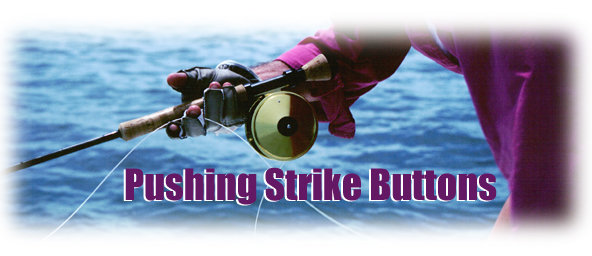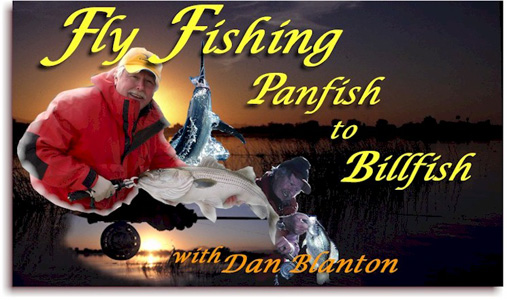 Pushing Strike Buttons
Pushing Strike Buttons
By Dan Blanton
Sean was livid. We’d been fly fishing for stripers, side-by-side, casting identical outfits, including the fly. I’d released more than a dozen bass to 15-pounds to Sean’s, two.
“What’s wrong?”, he asked, his voice filled with frustration and anxiety. “Is it my fly; my line?” “What?”, he impatiently quipped.
“Sean, it’s your retrieve.”, I responded. “You aren’t pushing their “strike buttons.”
I had been a player in this scenario hundreds of times. My partner just hadn’t learned yet how to push a stripers strike buttons as well as me. His retrieve was too slow with no variation. Same steady pulls, same length, same rate – no pauses or drops. The retrieve lacked imagination and, his poor results were strong testimony of it.
Know your quarry and what they eat.
Knowing your quarry’s habits, how and where they feed and upon what, will make a huge impact on your success. Study each species you seek. Consume biological data about both prey and bait species. Once you have become intimate with prevailing bait species – where they are found, what they look and act like, and how they interact with predators, you’ll begin to know how to choose the right fly and then retrieve it so it pushes strike buttons. Becoming familiar with these things, is the first step to improving retrieval techniques. But there’s more.
Getting their attention
Gamefish: stripers, bluefish, tarpon or billfish, can’t eat your fly until they see or feel its presence. In crystalline waters this is generally not a problem, put the fly within a few feet of the critter and its a marked target. Turbid or tannin water, or roiled surf – that’s another story.
A solid way to get a predator’s attention in off-colored or turbulent water is to begin your retrieve with a series of two to three ripping fast, long pulls, jumping the fly foreword, simultaneously pushing more water, creating sound waves species such as snook and stripers quickly home in on. Once the fish closes on your moniker, however, you may need to adjust your retrieve to prompt a strike – always imagine a predator tracking your fly…
Some like it slow and steady – no quick moves
 |
A quick-starting fly is an attention getter but it’s not for every species. Place a fly ten feet in front of a closing flats tarpon, wait until the fish is just a few feet away and then start it back like a dragster and you’ll scare the scales off it. Picking up the pace slightly when a tarpon tracks a fly is a good tactic, but don’t burn rubber. Ditto for a bonefish or most any other skinny water gamester. A slow, steady start, subtlety increasing speed will get you better results.
Flats permit respond well to a medium-quick start, getting their attention before dropping a crab fly straight to the bottom, employing the “no retrieve” technique for a positive pickup. And, river tarpon prefer the fly just hanging dead in down-stream current, imparting only an occasional twitch. I call this one the 15 minute retrieve. |
| A good cast with the right fly, fished with the right retrieve, pushed this leaping tarpon’s strike buttons. |
Some like it rocketing
Species like bonito and tuna often need a fly moving like it’s fitted with after-burners. The two handed retrieve is one way fly anglers get their frauds streaking: stick the rod grip under your arm pit and haul back line, hand-over-hand. Gets the fly moving pretty good. The same technique but only dead slow and steady, will out-produce any other muse for stripers feeding at night on sand eels.
Another approach to speed, is to cast the fly near a fish, start a single-handed pull for a few feet to get its attention and then quickly sweep the rod tip around in a horizontal arch as far back as you can reach, smoking the fly a few yards. Strikes are blinding! Another trick is to go to a fly about half the size of prevailing baitfish. Being smaller, it will present the illusion of speed – sport car vs. Mac truck. If all attempts using blistering retrieves fail, try nymphing it along, using short, two to three inch twitches, followed by pauses. I’ve taken many tuna, bonito and mackerel using this “crippled bait” tactic. For False albacore just twitching the fly amoungst boiling fish, keeping it right in their face, has produced hugely for me.
Make it look like an injured or frantic baitfish
I’m convinced that an erratic, variable-speed, retrieve, with lots of pauses to drop the fly like an injured bait, works best on most gamefish, particularly striped bass. If a fish, like a striper, only bumps the fly, I try hard not to instinctively set-strike, stopping the retrieve instead, letting the simulator fall like it has been stunned. Many times the fake will be taken on the sink or on the next series of ripping, long pulls, which I believe, makes the predator perceive it’s quarry as revived, trying to escape. Flies that have built-in dipping and diving action make a positive difference here. Finally, when casting to predators blasting dense, surface bait schools, try just letting your fly flutter downward through the bait, like a cripple. You’ll be amazed at how many big fish, particularly wahoo and King mackerel, will eat your fly as it descends below the surface carnage. Lots of side and tail flash built into your fly is a plus.
Tease/incite them into a frenzy
Some critters just turn off, or are unimpressed by standard retrieves – you just can’t move the fly fast enough, long enough, or they’ve recognized the difference between live bait (chum) and your fly. Barracuda, school dolphin, tuna and bonito are good examples. A good tactic with these is to repeatedly slap the fly and line down on the surface near the fish, quickly ripping the works back off, creating a noisy disturbance. Do this several times, lay the line down and begin a normal retrieve. You’ll be amazed at how well this tactic pushes strike buttons.

The result of pushing this tarpon’s strike button.
Books on baitfish and fly rod imitation
The two books listed below are excellent guides to knowing and understanding marine baitfish and how to simulate them with flies. D.B.
A Fly-fisher’s Guide To Saltwater Naturals And Their Imitation
by George V. Roberts
Ragged Mountain Press – 1994
Lou Tabory’s Guide to Saltwater Baits & Their Imitations
by Lou Tabory
Lyons & Buford – 1995
